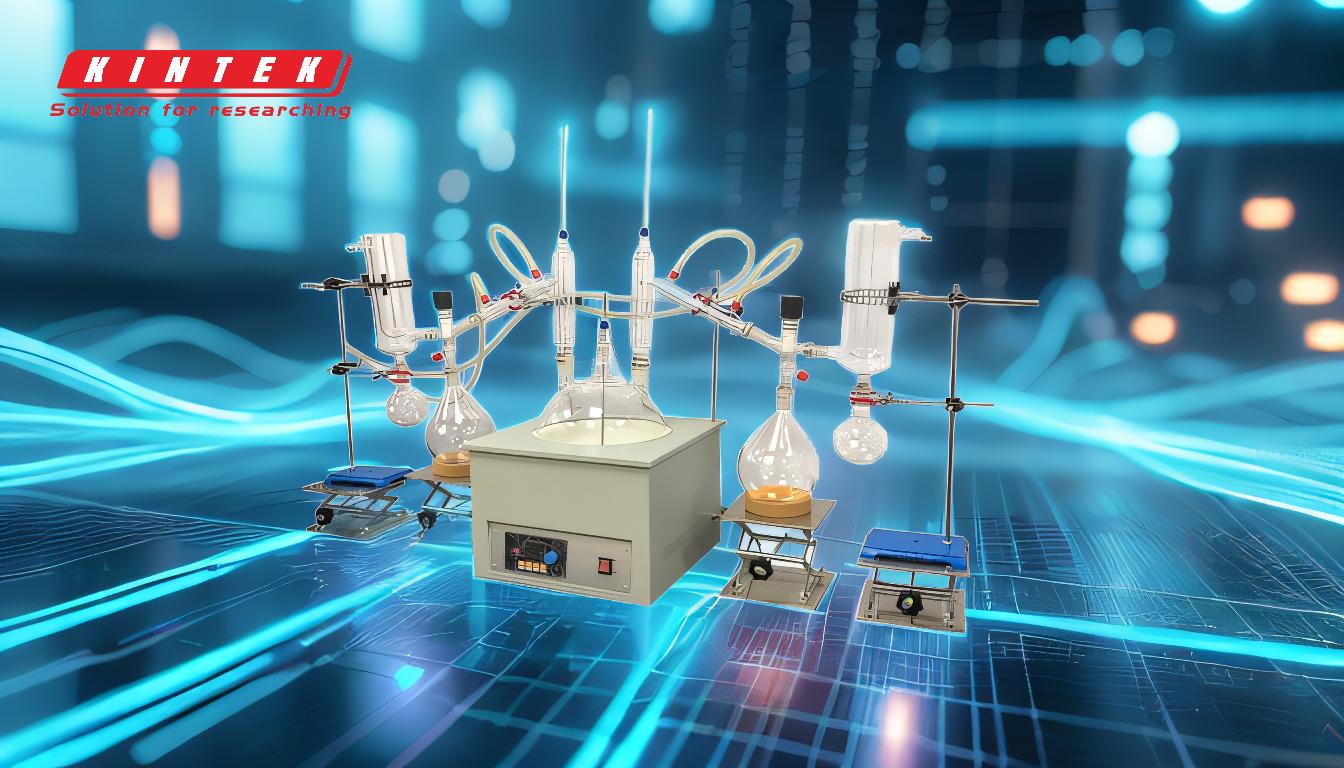Vacuum distillation is a critical technique for separating high-boiling-point compounds or heat-sensitive materials by lowering the surrounding pressure, which reduces the boiling points of the components. This process prevents thermal degradation, minimizes oxidation, and ensures efficient separation of compounds that would otherwise decompose at higher temperatures. The vacuum system, including pumps, controllers, and seals, plays a vital role in maintaining optimal pressure levels for distillation. By operating at lower temperatures and pressures, vacuum distillation preserves the quality of sensitive materials, such as cannabis extracts, and enhances the efficiency of the distillation process.
Key Points Explained:

-
Lowering Boiling Points:
- Vacuum distillation reduces the boiling points of compounds by lowering the surrounding pressure. This is based on the principle that boiling occurs when the vapor pressure of a liquid equals the external pressure.
- Example: A compound that normally boils at 400°F at atmospheric pressure may boil at 200°F under vacuum, preventing thermal degradation.
- This is particularly useful for heat-sensitive materials, such as pharmaceuticals, essential oils, or cannabis extracts, which can decompose at high temperatures.
-
Preventing Thermal Degradation:
- By operating at lower temperatures, vacuum distillation minimizes the risk of thermal decomposition, which is common in high-boiling-point compounds.
- Example: Compounds like polymers, vitamins, or natural extracts can break down when exposed to high heat, but vacuum distillation preserves their integrity.
-
Oxidation Prevention:
- Vacuum systems remove oxygen from the distillation environment, reducing the risk of oxidation.
- Oxidation can degrade the quality of sensitive materials, such as cannabis extracts or essential oils, leading to discoloration, loss of potency, or unwanted chemical reactions.
-
Efficient Separation of High-Boiling-Point Compounds:
- Vacuum distillation is ideal for separating compounds with boiling points above 392°F (200°C) that are difficult to distill at atmospheric pressure.
- Example: Aromatic compounds, heavy hydrocarbons, or complex mixtures can be separated more effectively under vacuum.
-
Role of Vacuum System Components:
- Vacuum Pump: Generates the required low-pressure environment. The pump's performance determines the system's vacuum level.
- Vacuum Controller: Regulates the pressure to ensure consistent and precise distillation conditions.
- Sealing Rings and Tubes: Maintain the integrity of the vacuum system, preventing leaks that could compromise the distillation process.
-
Energy and Resource Efficiency:
- Lower operating temperatures reduce energy consumption, making vacuum distillation more cost-effective.
- Automated vacuum controllers optimize pump operation, extending the lifespan of the equipment and saving resources.
-
Applications in Various Industries:
- Pharmaceuticals: Used to purify heat-sensitive drugs and active pharmaceutical ingredients (APIs).
- Essential Oils: Preserves the delicate aromas and therapeutic properties of plant extracts.
- Cannabis Extraction: Ensures high-purity distillates by preventing degradation of cannabinoids and terpenes.
- Petrochemicals: Separates heavy hydrocarbons and complex mixtures in refineries.
-
Short Path Distillation:
- A specialized form of vacuum distillation where the distance between the evaporator and condenser is minimized.
- This technique is particularly effective for purifying high-value, heat-sensitive materials, such as cannabinoids or rare chemicals.
-
Combination with Other Techniques:
- Vacuum distillation is often combined with steam or fractional distillation to enhance separation efficiency.
- Example: Steam distillation can be used to separate volatile aromatic compounds, while vacuum distillation handles high-boiling-point components.
-
Safety Considerations:
- Proper vacuum control prevents "explosion boiling," a phenomenon where rapid vaporization can cause splashing or system damage.
- Monitoring and maintaining the vacuum level ensures safe and efficient operation.
In summary, vacuum distillation is a versatile and efficient method for separating high-boiling-point or heat-sensitive compounds. By lowering the pressure and boiling points, it preserves the quality of materials, prevents degradation, and enhances separation efficiency. The integration of advanced vacuum systems and controllers further optimizes the process, making it indispensable in industries ranging from pharmaceuticals to petrochemicals.
Summary Table:
| Key Aspect | Description |
|---|---|
| Lowering Boiling Points | Reduces boiling points by lowering pressure, preventing thermal degradation. |
| Thermal Degradation Prevention | Operates at lower temperatures to preserve heat-sensitive compounds. |
| Oxidation Prevention | Removes oxygen to protect sensitive materials like cannabis extracts. |
| Efficient Separation | Ideal for high-boiling-point compounds above 392°F (200°C). |
| Vacuum System Components | Includes pumps, controllers, and seals to maintain optimal pressure. |
| Energy Efficiency | Lower temperatures reduce energy consumption and operational costs. |
| Applications | Pharmaceuticals, essential oils, cannabis extraction, and petrochemicals. |
Discover how vacuum distillation can optimize your processes—contact our experts today!












